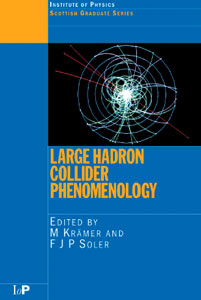by M Krämer and F J P Soler (eds), Institute of Physics Publishing. Hardback ISBN 0750309865, £75 ($125).
The Large Hadron Collider (LHC) is often described as the machine needed by the worldwide community of high-energy particle physics experimentalists and theorists to search for and, it is hoped, discover physics signals beyond those expected from the Standard Model of particle interactions. The general-purpose experiments now completing construction (ATLAS and CMS) are often described as huge facilities optimized for the search for the elusive Higgs boson, the one key element missing in the Standard Model. About three years from now, the whole community in our field will focus on new and, we hope, unexpected physics results. These will cover a wide range of topics, extending over all possible theoretical conjectures published to date, that are relevant to experiments at the scale of tera-electron-volts.

Given the dearth of guidance from experiments (aside from the beautiful but maddening agreement of even the most precise measurements with the predictions of the Standard Model), the driving goal of all theoretical developments beyond this very same Standard Model is that of solving the many fundamental issues in particle physics, which today are also relevant to cosmology, a science that has become much more mature experimentally over the past 10 years or so.
This book presents a series of lectures attempting to cover LHC phenomenology in the broadest possible sense. They range on one side from the intricacies of scalar fields, string theory and extra dimensions, to the basics of detector physics, which for more than 10 years has guided R&D in our field. This has led to the optimized design of the huge and complex detectors needed to extract minute signals from the huge backgrounds, involving today’s exciting physics (electroweak gauge-boson production, quantum chromodynamic multi-jet events, and heavy flavour production). But the lectures also range from accelerator science to modern e-science (the birth of the computing Grid) and from the less well known intricacies of heavy-ion physics to those of forward physics, where diffractive and quasi-elastic phenomena dominate.
These lectures were meant for today’s young physicists, many of whom will surely be the driving force behind the physics analyses and publications of the LHC experiments over the coming years. They were delivered on the occasion of the 57th Scottish Universities Summer School in Physics in summer 2003, by a well balanced mix of experienced theorists (D Ross, K Ellis and J Ellis) and seasoned experimentalists (V Gibson, H Hoffmann, B Müller, M A Parker, A de Roeck, R Schmidt and T S Virdee).
The emphasis in most of the lectures was on giving a snapshot of the current status of understanding in theory, phenomenology and accelerator and detector performance. The inevitable fate of such snapshots is to become fairly quickly obsolete, given the huge ongoing development of both the hardware and the software (should one add the middleware?) needed to operate the experiments, to simulate their performance accurately, to analyse their data quickly but unerringly, and to give a fair chance to all participants on all continents to join in the fun in the summer of 2007. Another drawback of such attempts is that, unavoidably, certain topics are treated superficially. However, I believe upon reading large sections of the book that this is largely outweighed by the benefit, for the young and less young reader, of finding in one volume a really complete coverage of all aspects relevant to LHC physics with a sufficiently rich bibliography to pursue in-depth reading.
For example, the reader interested in the phenomenology of quantum chromodynamic (QCD) beyond its direct application to LHC physics is referred to the book QCD and Collider Physics (by K Ellis, J Stirling and B Webber, 1996), the reader interested in more in-depth studies of accelerator physics and technology is referred to the Handbook of Accelerator Physics and Engineering (by A Chao and M Tigner, 2002), and the reader interested in the design and optimization of the general-purpose ATLAS and CMS detectors is referred to “Experimental challenges in high luminosity collider physics” (by N Ellis and T S Virdee, Ann. Rev. Nucl. Part. Sci. 44 609, 1994) and to all the Technical Design Reports published from these experiments between 1996 and 2005.
In summary, this book is an excellent introduction to LHC physics for any person entering the field now, at a moment when a huge effort from the whole community is still ongoing to meet the difficult challenge of assembling the various jigsaws needed to observe the first proton-proton collisions at the tera-electron-volt scale in summer 2007.
The reader has to be aware though that, apart from the foundations of the Standard Model, of supersymmetric and string theories, and of particle interactions in matter, many of the details provided in the lectures to illustrate the wonderful and exciting potential of the LHC and its associated detectors are to be considered as examples only. These will most likely bear little resemblance to the results published in the final publications a few (or many) years from now. I believe that most experimentalists, who have devoted a large fraction of their professional lives to make the LHC dream come true, hope that reality at the tera-electron-volt scale is something quite different from what has been envisaged to date by our theory colleagues. It is indeed the fulfilment of such a hope that can give a new and much needed impetus to our field, thereby surely opening up rich and thrilling prospects for the generations of theorists and experimentalists to come.







